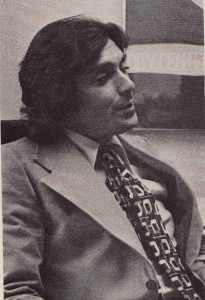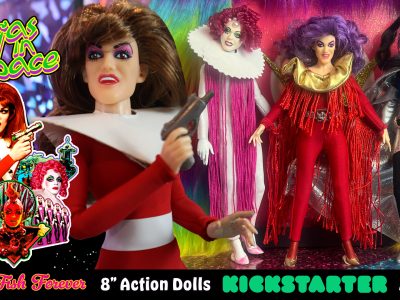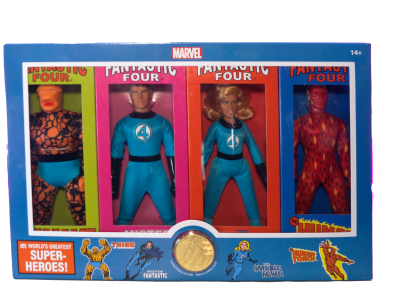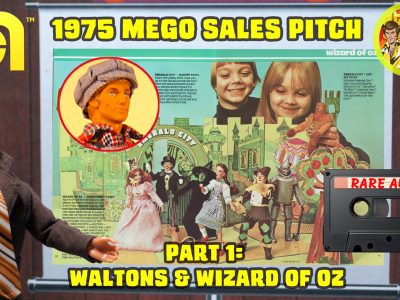This 1974 Interview with then Mego president Marty Abrams is a new discovery here at the Museum. The second installment (You can find Part one here) speaks specifically to Abram’s philosophy on licensing, his past experiences and what he believes is a good license particularly Planet of the Apes, the Superheroes and his latest Evel Knievel. Enjoy.
INTERVIEWER: Part of your whole philosophy is to go after established characters, established products?
ABRAMS: We’ve expanded our business for ’75, and we’re touching other areas. Yes, we want to go after established properties.
INTERVIEWER: Are you also going to introduce an Evel Knievel articulated figure?
ABRAMS: That is not part of our license. That happens to be one of our competitors.
INTERVIEWER: You also mentioned bicycles. Is that diversification part of a trend for the company?
ABRAMS: Yes, it is. [Editor’s Note: Click here to see Mego’s 1975 Evel Knievel Product Line]

INTERVIEWER: Are there other lines you can talk about that you’ll be going into in 1975?
ABRAMS: If this interview took place four weeks from now for the January issue, I could probably tell
you the whole line. We’re just about a month short of what we’re doing for ’75.
INTERVIEWER: Can we say there will be further diversifications than bicycles in ’75?
ABRAMS: Absolutely.
INTERVIEWER: So you’re going for a broader base?
ABRAMS: We are taking our steps very, very carefully. You always do first what you do best. Once you build a solid financial foundation and a solid product foundation and you have a reservoir of income coming in from your foundations, then you have the opportunity to step out and try other areas that the company has not done before. Now it takes more than just finances; it takes proper manufacturing and proper marketing and proper research and development. And we have made those adjustments and those steps in the last three years which has allowed us to expand our overall business, and we are not doing it shooting from the hip. We are doing it on a very carefully oriented basis. We’re very excited about our ’75 line.
INTERVIEWER: With diversification in your near future, you obviously have a very optimistic feeling about this
Christmas and ’75.
ABRAMS: Our business today, the way it is structured, is that of a world-wide manufacturing company. We have distribution in every major European country, as well as Australia, Japan and Canada. Our manufacturing base has allowed us to penetrate these markets very, very effectively. We are fortunate to have our properties be highly successful in all these markets, as well as the United States. Just that assumption has given us a very optimistic look because we are not totally oriented to the United States market. And all our distributors world-wide have come to the same conclusion about the Mego product development, that it is done with careful thought, careful foresight, with the right attitude.
Their penetration to their markets has been equivalent to what it is in the country. It’s been a total sell-through from the manufacturing end to the importing end to the distribution end, to the customer end, to the ultimate consumer. With that being the base, for .the next 36 months, we are looking at a very comfortable, optimistic point of view from our end of the industry for our company.
TOYS: How do you feel about the United States toy market specifically?
ABRAMS: The United States toy market specifically is really a mixed bag. I really believe that the retailers who are planning a disaster are going to have one. And the ones I who are going out to get the business and are taking positions are going to have the strong years. I saw this trend happen about 12 months ago because of my European distribution. When they pulled the plug on England and the people were not working two days a week, the English toy market had its best year ever in the history of the toy business. And it was specifically because the retailers and the manufacturers went out after the business. They saw an impending disaster and because they saw that impending disaster, they went out and fought for the business and what happened was there was a clear out on the shelves infltable projector screens in Britain.
Now that has changed little bit this year. But we really following in terms of our past year behind them in terms of the inflationary period. I think specifically Christmas ’74 … I’m going to look past December because world events are moving so quickly in terms of raw matcrial and oil and food and energy this year if the business is reaching for, it can be had very comfortably.
INTERVIEWER; I can’t help but to draw certain implications from what you just said. You didn’t seem to be saying anything optimistic about our economy for the next year … in that you said we were a year behind England and judging by what happened to the English economy over the past 12 months . . .
ABRAMS: I was specifically referring to the toy industry. The world economy in terms of what’s happening, Every time we pick up the Wall Street Journal or any of the financial publications or use the Walton Economic Marginal or referring to the Rand Corporation or any of the economic institutions. Everyone has a different opinion on it. They’re far more into the economic problems than I am. I’m just talking specifically for our industry.
INTERVIEWER: You have been consistently speaking about the stability and the long-term aspect of your license characters. What happens with something like Planet of the Apes if the T.V. series flops?
ABRAMS: That is specifically the reason we do not like to put indiscriminate licenses on a product. There has to be an intrinsic value of the property on a product as a combination. It happened with Davy Crockett; it happened with Hop-A-Longg Cassidy before him; it happened with Batman after him; and ultimately somewhere along the line it’s going to happen to the Planet of the Apes. In the relatively short period of time, the next 24 months, I don’t see that happening.

The demographics have come out on the Planet of the Apes series and they are extraordinary. We’re marketing for the ten-year-old child and under and even above that, they’re extraordinary. The series is number 1 in children and number 1 in male teens. We work very closely with Twentieth Century in terms of what their plans are. They have signed Roddy McDowell for a contract for this characterization and although they have already established merchandising rights to the property, they’re giving Roddy part of the action on merchandising rights. because he’s prepared mentally to devote seven years of his life to this property. Now that’s the opsimistic attitude. But over and above that. they’re working on an animated cartoon feature which will follow up the success of this program. Animated cartoon features are what’s happened to the Brady Bunch, the Harlem Globe Trotters; the Genie series.
Series. They’ve taken the programs and kept them going that way. So we have that as a backup to the show. They signed a guaranteed minimum of 26 shows that CBS has guaranteed Twentieth Century Fox which is two years of programming, Which goes into syndication even if the show does not get cancelled. So we have syndication, animated cartoons plus the intrinsic value of our property vs. other areas that just have licensing. So we look in terms
of this property as not a short-term, as quite definitely a medium term, and if it’s done properly in terms of our merchandising and our marketing, we feel it’s going to be a long-term product category.
INTERVIEWER: Can you at this point, or is it too early to discuss, other license characters that you’re looking into for ’75?
ABRAMS: All I can say is that ’74 was a terrific year for licensed properties for Mego and 1 think ’75 is going to be a blockbuster.
INTERVIEWER: How much stress will you be putting, new programs in particular, on first quarter sales in promotions?
ABRAMS: Well, for the first time, first quarter sales of ’75, Mego has planned a major first quarter advertising program in the major spot\markets of the country to follow through the success that we’ve had since early summer in our product categories.
INTERVIEWER: Can you be more specific than that?
ABRAMS: The final plans in terms of spot markets have really not been finalized. The overall budget will run about $350,000 for the first quarter.
INTERVIEWER: How does this compare with recent previous years?
ABRAMS: There is really no comparison. We ran no T.V. advertising last year in the first quarter. So this is a total increase.
INTERVIEWER: Why is this trend now taking place for the first quarter promotions?
ABRAMS: We built a very solid first quarter product line and we’re going to maintain the excitement of our product on a continuity basis through our calendar ’75.
INTERVIEWER: In going back again to the articulated figures, I assume that despite your diversification that you’re hinting at, they will still be the major portion of your business in ’75. Is that correct?
ABRAMS: I’d agree with that assumption.
INTERVIEWER: Then staying with that, how does a company like Mego deal with very popular characters in terms of rapidly changing trends that we do have in the market place, in terms of inventory and your own commit ment to the character? How do you know what kind of a life span you can expect from something like a Super Hero like Planet of the Apes with the rapidly changing market that we have?
ABRAMS: The fact of the matter is specifically Super Heroes. Bob Kane developed Batman in 1932-33. A whole range of Super Heroes came out during the depression years when the people wanted to get away from the trauma of everyday living. It was their fantasy, not just children but adults as well. The comic book characters were not originally developed for children. They were developed for adults. So that’s all 40 years of reservoir of everybody in this country, 220 million of us, all knowing who Batman and Superman and Robin were and are. And that continued right up to the Batman craze in 1966. Although the network show was discontinued from the air, it never stopped selling. The same thing I alluded to before happened. There was an over-abundance of the product.
Buyers got very wary of the product line because of all the product with nondescript nature with Batman labels that had come out, not just in the toy industry by the way. There was proliferation in every industry. So what happened was a total turn-off to buyers in our industry. But there were several products that continued to sell right along without any promotion. It was strictly off-the-shelf merchandise. And that is really what we’re talking about in terms of merchandising. If the product fits, it will always sell. It’s where there is no fit and it’s strictly taking advantage of a trend that you wind up with merchandising problems and product problems. And that’s why when we specifically look for a product, there has to come a time where there’s a down period. It’s happened in products such as Barbie, in products such as GI Joe.
They have their ups and; their downs, but the products are inherently viable products and they come back when a whole new wave of children come up and start all over again. After three or four yearsthe product is back. We see that, such as the Hoola Hoop, the Yo Yo. But there has to be a viability to the product and that’s what we look for.
INTERVIEWER: How can a buyer detect the difference between a character like Planet of the Apes and an item such as the Joe Namath figure?
ABRAMS: We learned a very interesting thing using Joe Namath. We learned who our public was. We learned the psyche of the kid who was buying the product line. And we also learned what to and what not to license in terms of real people. Evel Knievel himself has become almost a modern day Jack Armstrong or Superman unto himself.
The endorsing or licensing of properties of living people, because their popularity rises and falls so dramatically like Mark
s Spitz. By the time the product comes out on these people, their popularity has declined. And that’s what happened to Joe. It takes nine months to tool up. No matter what you do as you want to make a right product. He had won the Super Bowl, we were tooled up for next year, we were all poised as the season was about to get under way and he broke his leg and he lost his newspaper space. And once you lose your newspaper space, you lose your viability.
But creation of characters cannot happen. Batman continues to live on in animation and comic books,
in syndication. If anything happens to Roddy McDowell as a human being, it does not affect the figure Galen in the show. There is no identification. There’s voice identification, but they can substitute freely. And that happened, by the way, in the Flintstones. They freely substituted voices of characters that had been established for several years, but the people went on to other things. They didn’t want to continue to do the Flintstones. But the characters survived and the Flintstones in terms of product, are doing reasonably well. So that’s what we try to look for … the continuity of the character, not the immediate popularity of a figure at any given time.
INTERVIEWER: Well, how does Evel differ from that? He’s getting a lot of bad press right now.
ABRAMS: Evel differs in terms of reality. His press is so mixed as such that he will always be there. He is not structured within the framework of a team or an organization or a sporting event that takes other peopie to create. He creates his own publicity. He creates his own jump. He creates his own tour. He is the center theme. What Evel is doing is not dependent on anybody else to be successful. Evel is his own sucess. And that’s where he differs from the rest of these people. And he’s not competing against anyone else. He’s competing only against one person, and that’s Evel.








2 comments for “An Interview with Marty Abrams Part 2”